The resource panel gives you access to a wide variety of texts and tools that were designed to enhance your experience on the Sefaria site.
To open the resource panel, click on any text.
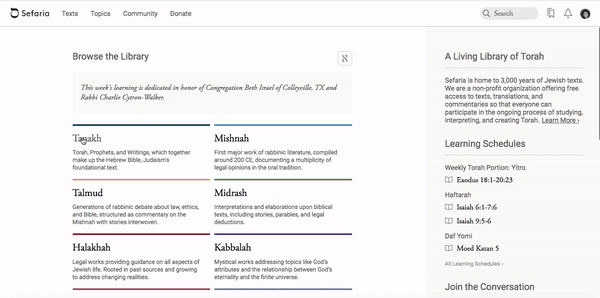
Scroll down to learn about each tool and get the most out of your Sefaria learning.
Contents:
2. What exactly is this text?
3. How do I navigate through the text?
4. How do I learn about the translation that I am reading? How do I switch to a different translation?
5. What is the "sheets" button and what is the number in the parenthesis?
6. What will I find if I click on "Web Pages"?
7. What is the "topics " button and what is the number in parenthesis?
8. What will I find if I click on “Manuscripts”?
9. Can I listen to someone chant the Torah passage that I'm reading?
10. How do I add a text directly to a sheet?
11. How do I look up a word in the dictionary while reading in the library?
12. What can I do with "Compare Text"?
13. How can I add notes to the database and who will see them?
14. How do I edit or delete a note?
15. How do I find my notes?
17. How can I easily share a text that I like with others?
18. How can I send feedback to Sefaria via the website?
19. How do I add a translation or edit an existing translation?
20. How do I add translations in languages other than English?
21. How do I add a connection?
1. Besides finding connections to the text, what else can I find in the resource panel?
The resource panel gives you access to a wide variety of texts and tools that were designed to enhance your experience on the Sefaria site. Each feature will be explained below.
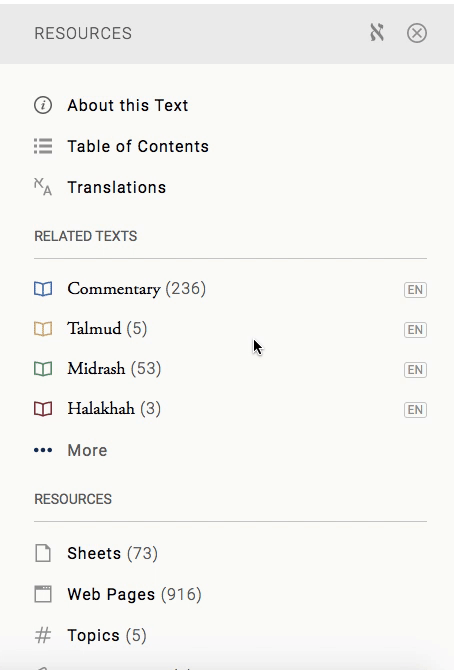
2. What exactly is this text?
Clicking on "About This Text" in the resource panel will give you information about the text that you are reading and will let you know which versions are being shown.
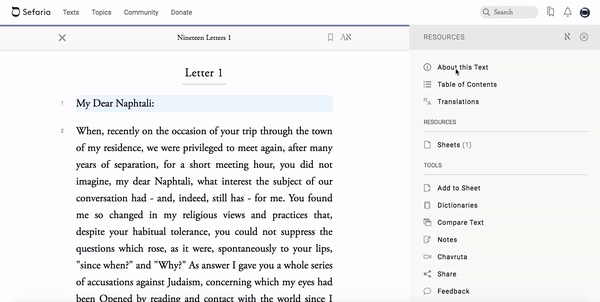
3. How do I navigate through the text?
Click on “Table of Contents” and navigate to your desired section of the text.
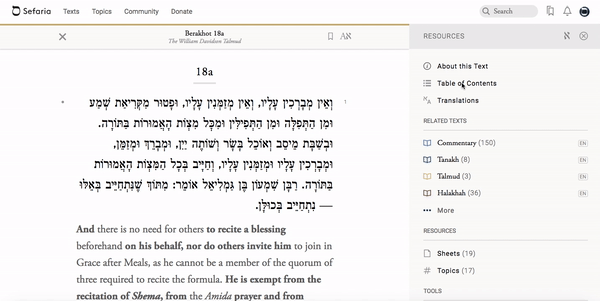
The table of contents for Torah includes an option to navigate by Torah portion (parashah) and aliyah.
- The Torah portions are located below the chapter indications.
- The numbers (1-7) below each parashah name indicate the aliyot. Click on any number to open to that particular aliyah.
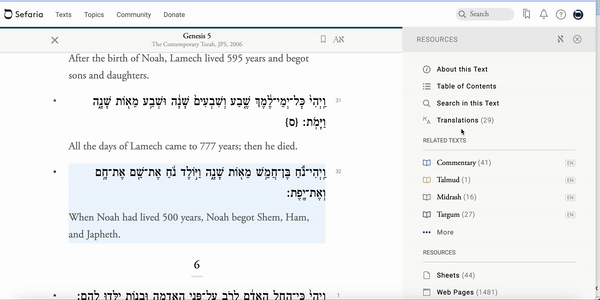
On the app, tap on the name of the text at the top of the screen to open the table of contents.
While reading a text, you can refer to the Torah portion section to see in which parashah and aliyah the verse is situated.

4. How do I learn about the translation that I am reading? How do I switch to a different translation?
For many texts, Sefaria hosts various translations. Information about the translations is located in the resource panel.
To choose your preferred translation:
1. Click "Translations" in the resource panel.
2. Choose the translation that you would like to use.
Once you choose a translation, it will remain your default translation on the site until you choose a different one.
Note: Choosing a Torah translation for one book sets the translation for all five books of the Torah.
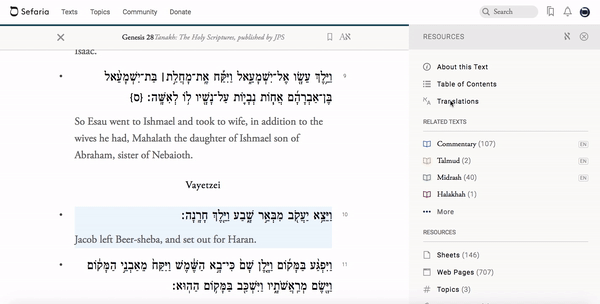
5. What is the "sheets" button and what is the number in the parenthesis?
Clicking on the sheets button will open a list of sheets that contain the primary text. The number in parenthesis is the number of public sheets that include the text. Click on the name of any sheet to open it next to the primary text.
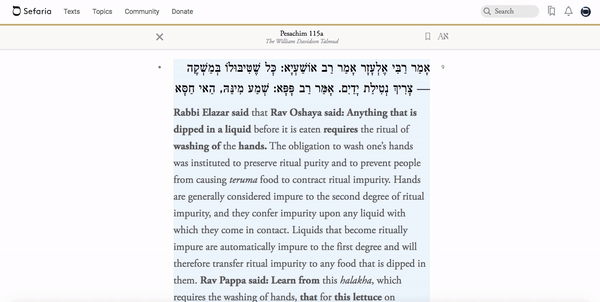
6. What will I find if I click on "Web Pages"?
Clicking on "Web Pages" will open a list of websites that use Sefaria's Linker on their site. The linker connects web posts to Sefaria when they quote a text. Websites such as My Jewish Learning, Rabbi Sacks, and the Virtual Beit Midrash use the linker and their posts are linked to the texts that they quote.
1. Click on "Web Pages"
2. Choose a website.
3. Peruse through posts from the site and open those that interest you.
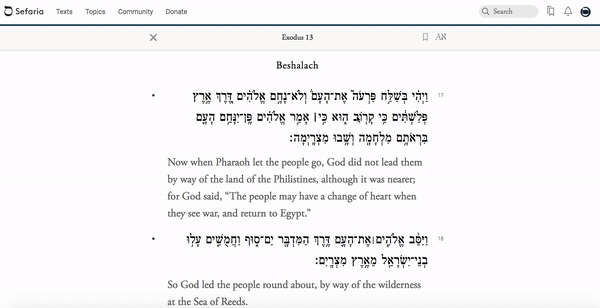
7. What is the "topics " button and what is the number in parenthesis?
Clicking on the topics button will take you to the list of topics pages related to the text. The number in parenthesis tells you how many topics pages are available. Click on the topic that you would like to learn about. For more information about topics, click here.
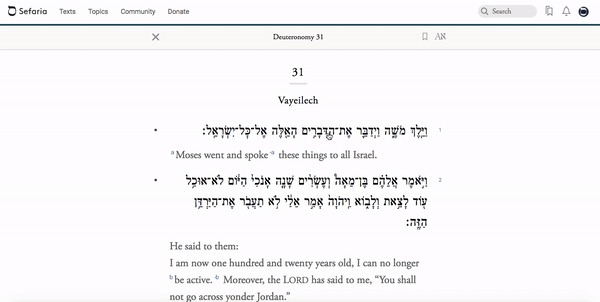
8. What will I find if I click on “Manuscripts”?
Thanks to the National Library of Israel’s tremendous work connecting manuscript images to texts, we can now offer these beautiful images in the Sefaria library linked to Talmud, Mishnah, and Tanakh.
To open a manuscript:
- Select “Manuscript” in the resource panel.
- Choose your preferred manuscript.
- Click on the image to enlarge it.
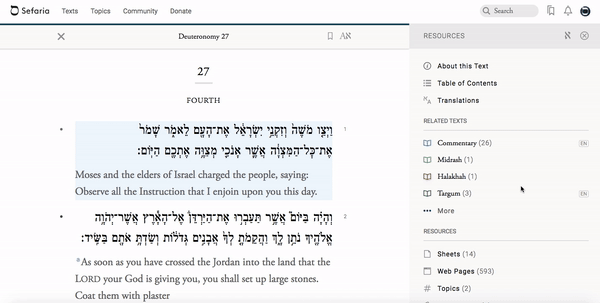
9. Can I listen to someone chant the Torah passage that I'm reading?
Yes! Click any verse in the Torah and select "Torah Readings" in the resource panel.
Click the play arrow to start the recording.
10. How do I add a text directly to a sheet?
You have found a text that you would like to add to a source sheet.
- With the resource panel open, select the text that you would like to add to a sheet. The selection can be multiple verses.
- Click on “Add to Sheet”
- Select the sheet that you would like to add the text to or create a new sheet.
- Click “Add to Sheet”
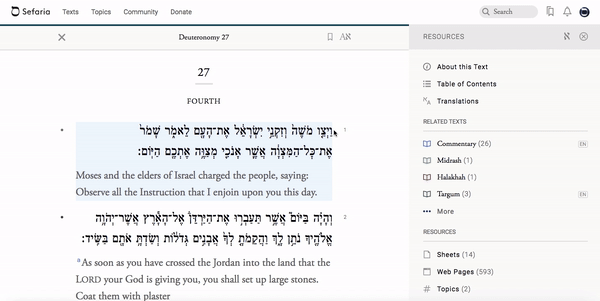
11. How do I look up a word in the dictionary while reading in the library?
There are two ways to look up a word while reading in the library.
1. Double click on the word that you would like defined and the dictionary entry appears in the resource panel.
2. Click on "Dictionaries" and type the word into the search bar.
For more information about Sefaria's reference works, see How Do I Use Sefaria's Reference Tools?
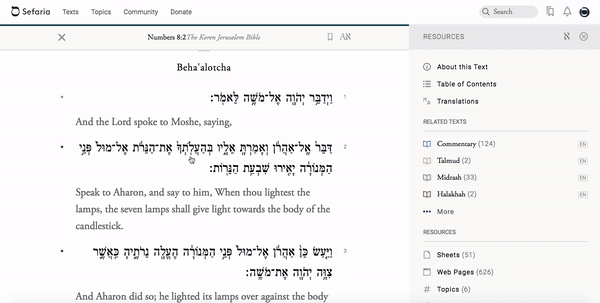
12. What can I do with "Compare Text"?
The "Compare Text" feature allows you to place any two or more texts side-by-side. You can scroll through each text independently.
1. Click on your first passage to open the "Resources" panel.
2. Click on "Compare Text".
3. A complete Table of Contents page will open next to your original text. Choose the text that you would like to place next to your text.
4. The two texts will now be displayed side-by-side.
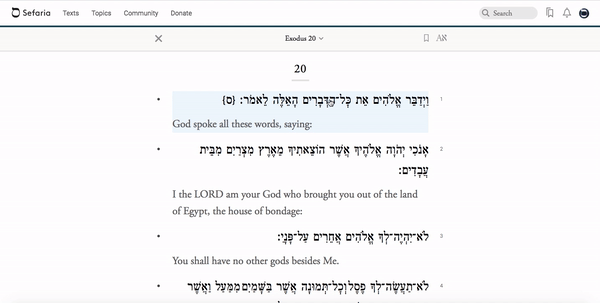
5. Another text can be added by following the same steps with the second selected text.
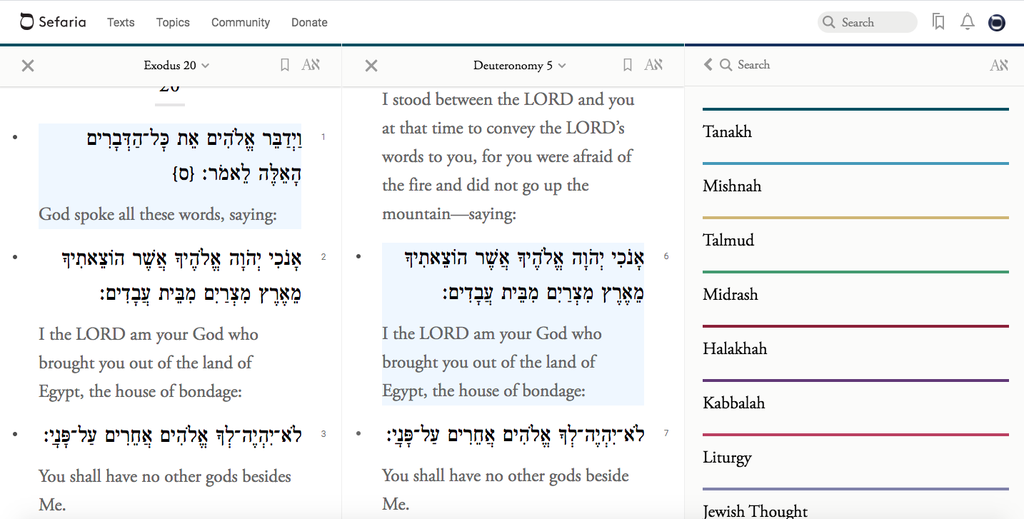
13. How can I add notes to the database and who will see them?
When you are on the website and logged into your account, you can add private notes to the database. The notes can only be seen by you. Notes can include links and text.
To add notes:
- Click on the verse or text to open the resource panel.
- Click on "Notes".
- Write your note. When adding a URL, use http or https.
- Click "Add Note".
- The note now appears in the resource panel.

14. How do I edit or delete a note?
- Click on “Notes” in the resource panel.
- Hover over the note to reveal the pencil. Click on the pencil.
- Edit the note and click “Save”. Click “Delete Note” if you wish to delete the note.

15. How do I find my notes?
There are three ways to find your notes.
- Click on the verse. The resource panel will open and “Notes” will indicate that you have a note. Clicking on "Notes" will open the note for you.

2. On the resource panel, click on "Go to My Notes" and a list of all of your notes will appear.
3. From the profile page, click on "Notes" and a list of all of your notes will appear.
The lists from #2 and #3 are helpful if you don't remember which verse you attached your note to.
16. Can I add a note directly to a source sheet?
Yes! To add a note to a source sheet:
- From the resource panel, click on “Notes” and then click on “Go to My Notes”.
- Click on “Add to Sheet” above the note you would like to add.
- Select the sheet that you would like to add the note to or create a new sheet.
- Click “Add to Sheet”.
17. How can I easily share a text that I like with others?
The "share" feature allows you to easily share a text by giving you the link or by sharing to Facebook, Twitter, or directly into an email with one click.
1. Click on "Share".
2. Choose how you would like to share the text.

18. How can I send feedback to Sefaria via the website?
While you are reading in the library, feel free to get in touch with our team. Using the resource panel, you can send us an email and get it sent to the proper department.
- Click on "Feedback"
- Select the type of feedback you would like to give, such as a bug report, a request for help, or even a hearty thank you.
- Write the text of the email and press "Send".
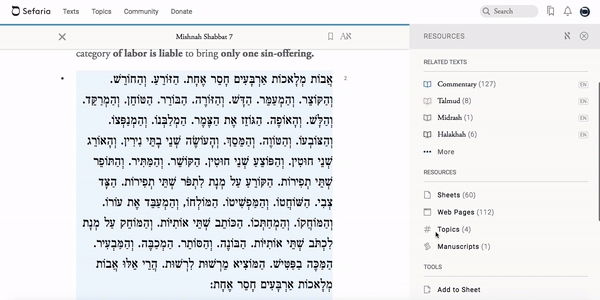
19. How do I add a translation or edit an existing translation?
1. Click on "Advanced".
2. Select "Add Translation".
3. Type your translation and click "Save".
4. Sefaria community translations can be edited by users.

20. How do I add translations in languages other than English?
- Always list non-English translations as Copied Text. Please do not enter non-English translations under Original Translation.
- The Version Title of your translation should clearly indicate its language in a way a normal user would understand.
- The Version Title should end with the two character language code in brackets, (e.g., [fr]). This will help us automatically find and categorize translations when we deal with them better in the future.
Translations will be accessible to others by selecting a text version in the Text Table of Contents page, which you see by clicking the text title in the header of a text.
21. How do I add a connection?
Thousands of connections have been made between texts in the Sefaria library. If you find a connection between two texts that hasn't already been made, you can add it yourself by following these steps:
1. Click “Advanced” and then “Add Connection”.
2. A Table of Contents page will open up. Select the text you would like to connect to the first text. Your two texts are now side-by-side.
3. Click on the second text. A third panel will open.
4. Select your type of connection and “Add Connection”.





